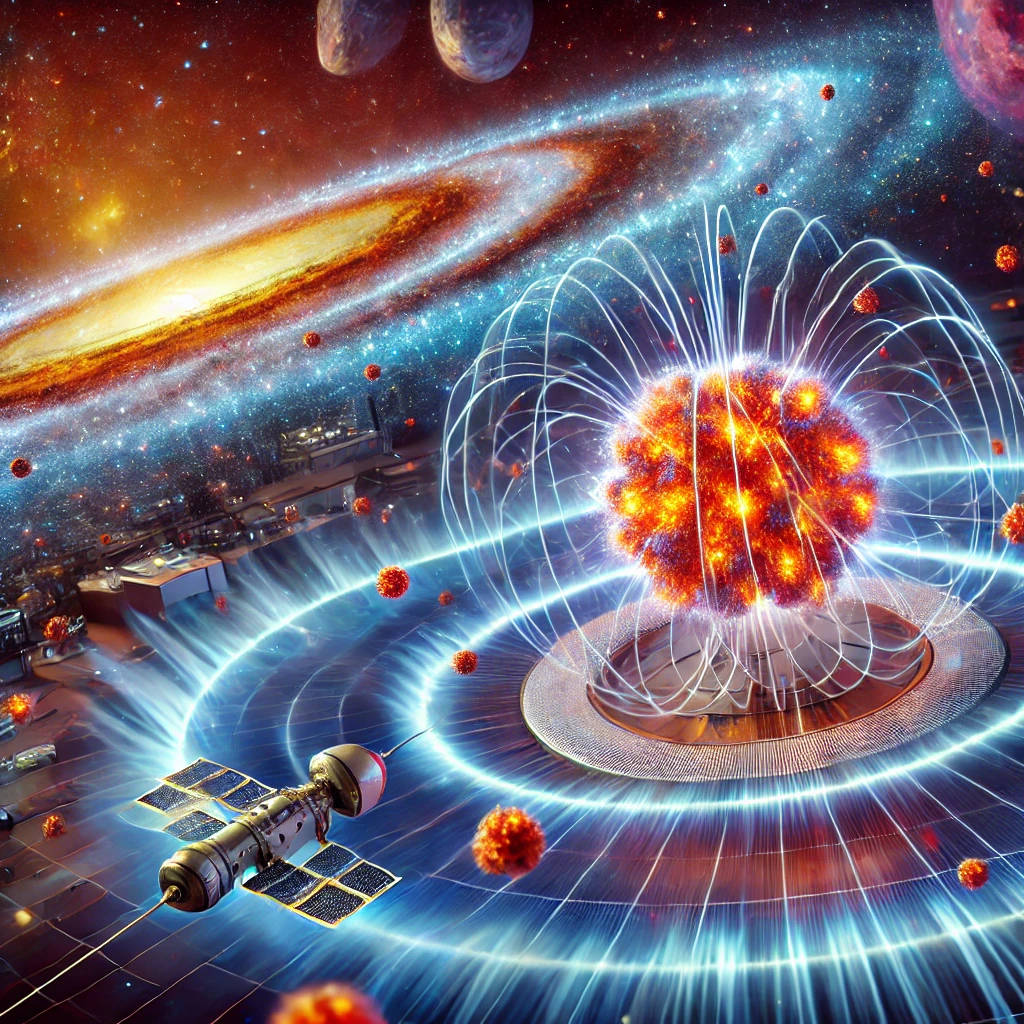Greetings, fellow space travelers! Captain Nova here, broadcasting from the Odyssey Explorer on Day 48 of our 100 Days of Space Exploration journey. Today, we venture into one of the most mysterious and invisible dangers of deep space—cosmic rays and space radiation. These high-energy particles and radiation sources pose significant challenges to both astronauts and spacecraft, making space travel a risky endeavor. So, what exactly are cosmic rays, where do they come from, and how do we protect ourselves from them? Let’s find out.

What Are Cosmic Rays?
Cosmic rays are highly energetic subatomic particles that travel through space at nearly the speed of light. Unlike the rays of sunlight we feel on our skin, cosmic rays consist of charged particles—primarily protons, electrons, and atomic nuclei—originating from a variety of cosmic sources. When these particles collide with the Earth’s atmosphere, they create showers of secondary particles, some of which reach the surface.
There are two main types of cosmic rays:
1. Galactic Cosmic Rays (GCRs)
GCRs are the remnants of powerful astrophysical events, such as supernova explosions and activity from black holes. These high-energy particles originate from outside our solar system, traveling vast distances before reaching us. Due to their immense energy, GCRs can penetrate deep into spacecraft and even human tissue, making them a major concern for space travelers.
2. Solar Cosmic Rays (SCRs)
SCRs are produced by the Sun, particularly during solar flares and coronal mass ejections (CMEs). Unlike GCRs, these particles have lower energy but can still be hazardous during intense solar storms. Since they come from our own star, they are more predictable and easier to shield against compared to GCRs.
How Cosmic Rays Affect Space Exploration
Cosmic rays pose a significant risk to both astronauts and spacecraft. Here’s how:
1. Radiation Exposure to Astronauts
Unlike on Earth, where our atmosphere and magnetic field provide protection, astronauts in space are exposed to much higher levels of radiation. Prolonged exposure to cosmic rays can lead to:
- DNA damage and increased cancer risks
- Neurological effects, including cognitive decline
- Potential damage to the circulatory system
- Acute radiation sickness in extreme cases
For astronauts on long-duration missions, such as a journey to Mars, cosmic radiation exposure is a major health concern. Current space suits and spacecraft provide limited shielding, so scientists are working on advanced radiation protection technologies.
2. Damage to Spacecraft Electronics
Cosmic rays can cause electronic malfunctions in spacecraft by inducing errors in microchips and onboard systems. This phenomenon, known as a single-event upset (SEU), can lead to:
- Data corruption in computers
- Failures in communication systems
- Malfunctions in navigation equipment
To mitigate this, engineers design spacecraft with radiation-hardened electronics and redundant systems to ensure mission success.
3. Impact on Future Space Missions
With humanity aiming for deeper space exploration—Mars, Europa, and beyond—the challenges posed by cosmic rays become even greater. Prolonged exposure during interplanetary travel requires innovative solutions, such as:
- Magnetic shielding to deflect charged particles
- Water-based barriers, as water is an excellent radiation absorber
- Underground habitats on the Moon or Mars for better protection
How Earth Protects Us from Cosmic Radiation
Here on Earth, we rarely think about cosmic rays because our planet provides two primary layers of protection:
1. Earth’s Magnetic Field
Our planet’s magnetic field acts as a shield, deflecting many incoming charged particles. This is why astronauts in low Earth orbit (LEO), such as those aboard the International Space Station (ISS), receive less radiation than those venturing beyond.
2. The Atmosphere
Even the most energetic cosmic rays struggle to penetrate Earth’s dense atmosphere. As they collide with air molecules, they break apart, losing much of their harmful energy before reaching the surface.
Protecting Astronauts from Space Radiation
With plans for human missions to Mars, space agencies are actively researching ways to safeguard astronauts. Some promising methods include:
1. Improved Spacecraft Shielding
Current spacecraft offer limited protection from cosmic rays. Future designs may incorporate:
- Thicker hulls with advanced materials
- Electromagnetic shields to repel charged particles
- Water or polyethylene-based radiation barriers
2. Artificial Magnetic Fields
Scientists are exploring the possibility of generating small magnetic fields around spacecraft to mimic Earth’s natural defense. This technology, while still in early stages, could dramatically reduce radiation exposure.
3. Underground Habitats on Other Worlds
Future Mars and Moon bases may be constructed underground or within lava tubes to take advantage of natural shielding against cosmic rays. This strategy would significantly reduce astronaut exposure.
Final Thoughts
Cosmic rays and space radiation remain one of the greatest obstacles to human space exploration. While Earth’s natural defenses keep us safe on the surface, venturing beyond our protective bubble exposes astronauts to invisible yet dangerous threats. With continued research and advancements in shielding technology, humanity is steadily preparing for a future among the stars.
As always, stay curious, keep looking up, and remember—the universe is full of wonders waiting to be explored.
Captain Nova
Odyssey Explorer
Leave a Reply